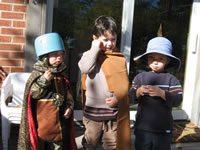Judy writes:  Children have an internal program that drives them to meet challenges and to practice new skills through play. Just as we do not need to teach a child to walk, we do not, and cannot, teach children how to play. Although fair play and social skills are not innate, the desire to work through life’s circumstances through creative free play is innate. Since children cannot intellectualize their experiences, they play them out with their bodies, and in doing so, they practice skills and learn how life works.
Children have an internal program that drives them to meet challenges and to practice new skills through play. Just as we do not need to teach a child to walk, we do not, and cannot, teach children how to play. Although fair play and social skills are not innate, the desire to work through life’s circumstances through creative free play is innate. Since children cannot intellectualize their experiences, they play them out with their bodies, and in doing so, they practice skills and learn how life works.
Since this remarkable capability cannot be directed by adults, it can be misunderstood. It lives in the domain of children, requiring special eyes to see it. When I do see it, it fills me with wonder. I’ve learned to trust the innate brilliance of children and not to interfere (unless safety is an issue) when children are engaged in playing out their challenges or practicing physical or social skills. The following examples will demonstrate some of the ways creative free play helps children learn how life works.
One toddler, when she started coming to the Center, was set free to adjust by a caring and trusting parent. Being new to the environment, the adults, and the children, she began creating a comfortable space for herself. She sat on the rug outside of her cubby and proceeded to place her clothing items one by one in a circle around herself. There she was amongst her familiar things, sometimes sitting up and occasionally, lying down. Teachers did not interfere, and overall, children respected what she was creating. Only when free playtime was over, the teachers helped her put away her things and come to the rug for circle or to the table for snack. Without understanding this child’s brilliance, an adult might tell her that clothes stay in the cubby, but on her own, the toddler came to this herself. One day, she did not need to surround herself with familiar things to feel secure, and she went off to play with the toys and the other children.
Another child was witnessing his mother’s illness, including surgical bandaging. Of course, he could not articulate what he and his mother were experiencing, but he was able to explore it in his own way. The teachers noticed that every day he would come in with band-aids all over his legs. At first they wondered about this behavior, but then they realized that he was experiencing a wound in the only way he knew how. Kudos to the parents who allowed him to find his way to understand life’s circumstances by playing being the patient and sympathizing with his mother.
Normally toddlers’ play is singular, but preschoolers often engage others in their play. I’ve seen children with new siblings play house, exploring different family roles, including being the baby. A child whose parents are divorcing or moving may create safety games. One boy would get into a close space and have another one sheath him with silks. Inside, in the warmth and the dark, he was experiencing control of his life’s situation, one over which he had no control. He was able to feel safe in his play, and have a friend help him create what he needed. Both boys engaged in the game, and both benefitted from playing it.
I’ve seen countless examples of this self-directed behavior, making sense of life’s circumstances and practicing skills through play. That’s why we allow children freedom in their creative free play. Their little bodies know what they need, and within certain parameters of safety, they can go about getting it. I regularly watch a little boy play at the kitchen in the community room, practicing cooking in a methodical and focused way. When mom returns, he serves her a morning cup of coffee, to the delight of both the server and the served. Clearly, he’s learning, and if we told him to do this job, he’d be less inclined to engage with such joy and attention; as it is, he is expressing his innate brilliance and the least we can do is to allow him to do so.
On the other hand, (there are always two hands), it’s my observation that while children explore what they need to do in creative free play, in the adult-directed realm, they ask us for more direction. Their innate brilliance does not include social mores. Those are the adults’ job to teach, for example, table manners, hand-washing, dressing for outdoors, resting, and so forth. As long as we adults understand where children are able to lead and where it’s best for the adults to lead, it’s possible to find gracefulness in the dance where children and adults live together.
This is the basis for a strong, trusting relationship, just what we aim for in early childhood and the foundation for a whole and healthy life.
Judith Frizlen is founder and director of The Rose Garden Children’s Center, a LifeWays Representative Program in Buffalo, New York.
